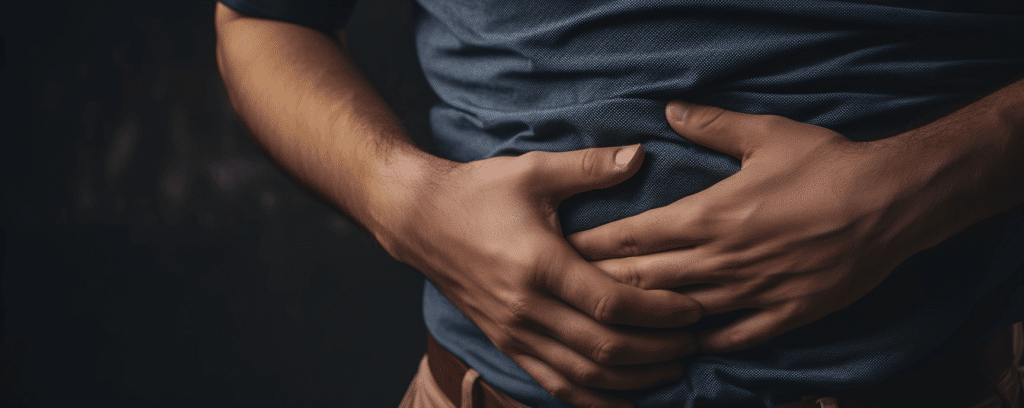
Are you feeling rib pain days after a car accident? Delayed rib pain after car accident can be confusing and alarming. This article addresses the reasons behind such discomfort, identifies when you should be concerned, and discusses next steps for care and recovery. With a clear focus on common injuries and treatment strategies related to delayed rib pain after car accident, you’ll be equipped with the knowledge to take the right action.
Key Takeaways
- Delayed rib pain after a car accident can be a result of fractured ribs, bruised ribs, or soft tissue injuries, often masked initially by adrenaline but manifesting as inflammation and pain later on.
- Symptoms of delayed rib pain, including sharp or dull pain, difficulty breathing, tenderness, and swelling, typically manifest within 14 to 18 days after the incident, and medical attention should be sought for persistent or worsening symptoms.
- Treatment options for delayed rib pain range from pain management with NSAIDs or opioids to physical therapy and, in severe cases, surgical intervention such as Surgical Stabilization of Rib Fractures (SSRF).
Contact us today and we will help you get the compensation that you deserve.
Understanding Delayed Rib Pain After a Car Accident
Delayed rib pain after a car accident is often a symptom of more severe injuries such as fractured ribs, bruised ribs, and soft tissue injuries. The impact and forces exerted during a car accident are such that they can lead to these painful injuries. One might wonder, why is the pain delayed? The answer lies in the adrenaline rush during a car accident. This adrenaline masks personal injury and pain by limiting pain signals sent to and from the brain, causing a delay in pain sensation.
Moving forward, we’ll examine these injuries and their role in causing delayed rib pain.
Fractured Ribs
Rib fractures are common post-trauma injuries following a car accident, along with traumatic brain injuries. In fact, around 30% of individuals involved in a car accident sustain at least one fractured rib. These fractures can lead to delayed pain as inflammation sets in following the trauma. Healthcare providers classify rib fractures as displaced or non-displaced, with displaced fractures often being more complex and sometimes requiring surgical intervention.
The recovery period from fractured ribs typically ranges from one to two months, but severe chest trauma can prolong the recovery time.
Bruised Ribs
Unlike fractured ribs, a bruised rib results from damage to the surrounding soft tissue, cartilage, and muscles without affecting the bones. The pain from bruised ribs may not be immediate. It develops due to blunt force trauma, such as that experienced in a car crash, which causes swelling and internal bleeding leading to delayed pain.
Bruised ribs can also result from falls, blows to the chest, or severe coughing, often manifesting as strong pain during breathing or coughing.
Soft Tissue Injuries
Sprains and strains of the muscles supporting the ribcage are common soft tissue injuries following the blunt force trauma experienced in a car accident. The inflammatory response to these injuries may mask pain symptoms for several days, leading to delayed pain around the ribcage.
Specific injuries, such as intercostal strains which involve the muscles that connect the rib bones to one another, can cause severe and lasting pain after a car accident. In some cases, a neck injury might also occur, leading to additional discomfort and potential spinal injuries.
Symptoms of Delayed Rib Pain
Timely treatment requires the early identification of delayed rib pain symptoms. These symptoms often manifest 14 to 18 days following the car accident, prompting patients to seek medical attention. Difficulty in breathing and pain during respiratory movements are notable symptoms when soft tissue injuries in the rib area occur.
Swelling and tenderness in the area around the ribs, sometimes coupled with visible skin bruising, signify bruised ribs as a cause of delayed rib pain. Let us now delve deeper into each of these symptoms.
Sharp or Dull Pain
The intensity of pain experienced from a fractured rib can vary depending on the person’s movements and activities. Specific actions such as bending, twisting the body, or pressing on the injury site can intensify the pain from a fractured rib. Even taking a deep breath can cause a sudden flare-up of pain, indicating the pain’s association with a fractured rib.
These variants of pain due to movement and pressure highlight the differing degrees of pain individuals may experience with delayed rib pain.
Difficulty Breathing
Difficulty breathing deeply or coughing can arise as a symptom of a rib fracture after a car accident. Symptoms of rib injury include pain when breathing, coughing, laughing, sneezing, or upon application of pressure on the chest. More severe symptoms like fever, shortness of breath, and coughing up blood can worsen the pain experienced from a rib fracture, particularly during activities like bending, twisting, or taking deep breaths.
For poorly controlled pain associated with breathing difficulties from a rib injury, regional anesthetic techniques such as paravertebral blocks and intercostal blocks are important for management.
Tenderness Around the Affected Area
Tenderness and swelling around the ribs can be a sign of bruised or broken ribs following a car accident. Some signs to look out for include:
- A tender or bruised spot on the rib area after a car accident
- Difficulty breathing or taking deep breaths
- Pain when coughing or sneezing
- Pain when moving or twisting the body
If you experience any of these symptoms, it is important to seek medical attention as it could indicate an injury to the ribs.
When to Seek Medical Attention for Delayed Rib Pain

- persistent chest tightness
- cough
- fever
- the first sign of rib pain after a car accident
It’s important to seek medical attention immediately. Potential complications such as torn blood vessels, injured organs, or more serious injury necessitate prompt medical attention for broken ribs.
Moving on, we’ll scrutinize these considerations more thoroughly.
Persistent Pain
If you have persistent pain in the rib area, evaluation by a healthcare provider is necessary. A healthcare provider can determine if the persistent pain is due to complications such as broken ribs that may not be immediately obvious.
If the rib pain post-injury interferes with breathing and daily activities, it should be promptly assessed by a medical professional.
Worsening Symptoms
Seeking medical help is crucial if additional symptoms develop following a rib injury. Serious symptoms that necessitate immediate medical attention after a rib injury include:
- Fever
- Shortness of breath
- Coughing up mucus or blood
- Chest pain
Medical assessment is advised for rib pain that worsens with deep breaths, pressure on the injured area, or bending and twisting of the body, as well as for stomach pain.
Potential Complications
Delayed or untreated rib pain can be indicative of serious conditions such as lung cancer or a pulmonary embolism, which can lead to life-threatening complications without prompt treatment. Not addressing rib pain after trauma can result in atelectasis, where part of the lung collapses due to the inability to breathe deeply, subsequently increasing the risk of pneumonia.
If rib pain following an accident is not treated, it can lead to the formation of scar tissue, which may result in chronic pain and a limited range of motion in the affected area. Hence, it’s crucial to seek immediate medical attention if you are experiencing persistent or worsening rib pain following a car accident.
Treatment Options for Delayed Rib Pain
Delayed rib pain can be treated using a variety of options such as pain management, physical therapy, and surgical intervention. The choice of treatment depends on the severity of the pain and the specific type of injury.
Next, we’ll examine these treatment options more comprehensively.
Pain Management
When it comes to pain management, over-the-counter nonsteroidal anti-inflammatory drugs (NSAIDs), such as ibuprofen, ketoprofen, and naproxen, are usually used for relief of pain associated with delayed rib injuries. For patients with conditions that make NSAIDs unsuitable, acetaminophen is an alternative, and for mild to moderate pain, physicians may prescribe combinations of acetaminophen with opioids like codeine or hydrocodone.
In cases of severe pain, controlled administration of morphine may be necessary.
Physical Therapy
Physical therapy is a vital part of the treatment plan for delayed rib pain. It aims to strengthen muscles and improve range of motion around the ribcage to facilitate recovery. Therapeutic exercises, modalities such as ultrasound, and manual therapy techniques like soft tissue and joint mobilization are all part of the physical therapy regimen.
Exercises like gentle range of motion exercises, thoracic mobilization, and yoga poses are crucial in preventing stiffness and sustaining the flexibility and strength of the ribcage. A comprehensive physical therapy approach combining targeted exercises with various manual techniques is crucial for long-term rehabilitation and prevention of persistent rib pain.
Surgical Intervention

The procedure includes:
- Comprehensive imaging
- Determination of surgical indications
- Selecting the appropriate surgical approach
- Choosing intubation options
- Possibly utilizing cryoablation for intercostal nerves
- Executing the rib fracture stabilization.
Preventing Further Rib Injuries After a Car Accident
Although treatment is vital, it’s often more beneficial to prevent the occurrence of an ailment. There are several measures one can take to prevent further rib injuries after a car accident. These include proper seatbelt usage, strengthening exercises, and safe driving habits.
Next, we’ll explore these preventative measures more thoroughly.
Proper Seatbelt Usage
Using seatbelts correctly is crucial for minimizing the risk of rib injuries during car accidents. The lap belt should be secured across the hips below the stomach, and the shoulder belt should cross the middle of the chest and be positioned away from the neck for proper protection.
It’s also important to remove any slack from the seat belt, ensuring it fits snugly across the body and provides the best protection in the event of a crash.
Strengthening Exercises
Engaging in exercises that strengthen the muscles around the ribs can help protect against further rib injuries. Core exercises such as planks and side planks are beneficial in fortifying the muscles that provide support to the rib cage.
Adding twisting motions to workouts, including exercises like the Russian twist, helps in building the strength and flexibility of the muscles surrounding the ribs.
Safe Driving Habits
Adopting safe driving habits reduces the overall chance of being involved in car accidents, thereby lowering the risk of rib injuries. Some safe driving habits to follow include:
- Adhering to traffic laws, such as speed limits and stop signs
- Maintaining a safe following distance
- Anticipating other drivers’ actions and being prepared to react
- Avoiding distractions while driving, such as texting or talking on the phone
By practicing these safe driving habits, you can help prevent accidents and reduce the risk of rib injuries.
Regular vehicle maintenance, including brake inspections and ensuring proper tire pressure, is crucial for safe driving to prevent accidents.
Legal Considerations for Delayed Rib Pain After a Car Accident
Delayed rib pain following a car accident doesn’t only have physical implications, it also brings about several legal considerations, including insurance claims, compensation seeking, and the potential requirement for legal advice.
In this section, we’ll delve into each of these aspects in more detail.
Filing Insurance Claims
When filing a claim, it’s crucial to prove that the delayed pain correlates with the recent accident, as it could be a symptom of post traumatic stress disorder. This can be substantiated by timely medical documentation. Not documenting injuries immediately after a car accident can raise doubts about the causation and severity of the injuries when filing insurance claims.
Sufficient documentation is essential in proving that car accident injuries occurred due to the car accident and to ascertain the extent of the injuries for compensation. An experienced car accident lawyer can help navigate the challenges that come with not having immediate medical documentation after an accident.
Seeking Compensation
The cost of treatment for delayed rib pain after a car accident can increase the amount of potential compensation claimed from insurance or in a lawsuit. It’s crucial to reach Maximum Medical Improvement (MMI) to ensure all delayed injuries, including those causing rib pain, are fully accounted for in the compensation claim.
Seeking legal advice is beneficial for properly evaluating the full extent of delayed rib pain injuries and obtaining an accurate compensation amount, particularly to cover potential future medical expenses.
Frequently Asked Questions
Can bruised ribs hurt months later?
Yes, bruised ribs can continue to hurt for months. If the pain worsens, it’s important to continue resting and seek medical advice as needed.
How long do ribs hurt after car accident?
Ribs can hurt for four to six weeks after a car accident. It is important to follow your doctor’s advice, including icing the area, taking pain medication, and getting plenty of rest.
What are 4 signs and symptoms of a rib fracture?
Common signs and symptoms of a rib fracture include strong chest pain when breathing or coughing, swelling or tenderness around the affected ribs, bruising, and a crackling sensation when the rib is broken. These symptoms should prompt immediate medical attention.
Why is pain delayed after car accident?
Pain can be delayed after a car accident due to the masking effects of adrenaline and endorphins, which can suppress awareness of injury for up to 24-48 hours, or even longer. It’s important to seek medical attention even if you don’t feel immediate pain.
How long does it take to mentally recover from a car accident?
Recovering from a car accident emotionally can take several months or even years, but counseling and therapy can help with the process. It is common for emotional responses like fear, sadness, and anger to decrease in the days and weeks following the crash. After a car crash, 70% of people are back at work within eight weeks.
Last updated Thursday, April 25th, 2024 | Written by Anthony B. Golden






